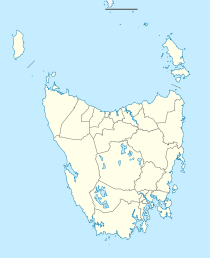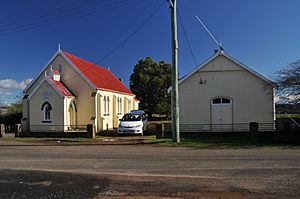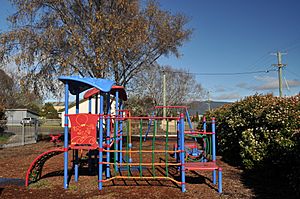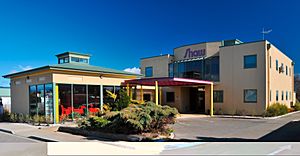Whitemore, Tasmania facts for kids
Quick facts for kids WhitemoreTasmania |
|||||||||||||||
|---|---|---|---|---|---|---|---|---|---|---|---|---|---|---|---|
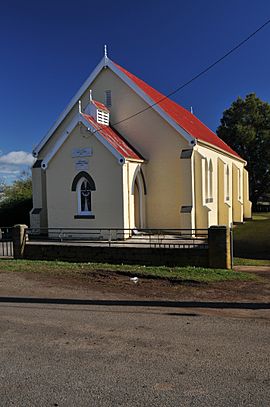
Whitemore's church, completed in 1865
|
|||||||||||||||
| Population | 198 (2016 census) | ||||||||||||||
| Established | c.1857 | ||||||||||||||
| Postcode(s) | 7303 | ||||||||||||||
| Elevation | 183 m (600 ft) | ||||||||||||||
| Location |
|
||||||||||||||
| LGA(s) | Meander Valley Council | ||||||||||||||
| Region | Launceston | ||||||||||||||
| State electorate(s) | Lyons | ||||||||||||||
| Federal Division(s) | Lyons | ||||||||||||||
|
|||||||||||||||
Whitemore is a small country town in Tasmania, Australia. It is located in the Meander Valley area, about 11 kilometres (7 miles) south-east of Westbury. In 2016, the town had a population of 198 people.
The land where Whitemore now stands was first given to Richard Dry in the 1830s. Later, in 1854, it was sold to William Hingston for farming. Hingston built a church, and other buildings soon followed. Over time, Whitemore had a blacksmith, a post office, a library, shops, and a petrol station. However, these businesses are no longer there today.
One of the most important businesses in Whitemore's history is Shaw Contracting. This is a large company that builds things like roads and bridges. Today, the town's main features are its brick church from 1864, the older wooden church (now a community hall), and the big workshops and offices of Shaw Contracting.
Contents
Whitemore's Past
Whitemore is part of what was once a large property called Quamby estate. Richard Dry, whose son later became the Premier of Tasmania, was granted this land in 1837. The area was settled by farmers for almost 20 years before it started to grow into a town.
In 1854, William Hingston bought some land here. He named his 120-acre (49-hectare) farm "Whitemoor farm." This name came from a farm his family had in Cornwall, England. Hingston helped the town grow by donating land for a church in 1857. This church was a Wesleyan chapel, and it became known as "Whitemoor chapel." The village that grew around the church eventually took this name. Around 1860, Hingston built "Whitemoor house" using bricks made right there in the area.
By 1865, Whitemore had a brick church, the original wooden church (which was used as a school), and two small houses. Even in 1915, there were only three houses in the town. In 1951, the local council bought land to build a hall to remember those who served in the World Wars. This hall was built by volunteers and opened in 1953. The main road through Whitemore was paved in the same year. Whitemore officially became a "locality" in 1968.
Getting Around Whitemore
The Bass Highway runs along the northern edge of Whitemore. This is a major road that goes from east to west. Other local roads, like Whitemore Road and Black Hills Road, help people get around the area.
Services and Utilities
Whitemore used to have a train service, which started in the late 1870s. The first passenger train arrived in 1870. However, the train service to Whitemore stopped before 1978. Today, the only regular public transport is a private school bus service.
In the past, one building in town was both a house and a shop, starting in 1859. A petrol pump was added outside the shop in the late 1920s. A post office opened in 1871 at the train siding. By 1908, the post office moved to the chapel house in the main part of town, and a shop also operated from there. This building served as a store, telephone exchange, and petrol station for about 70 years. The post office closed in 1977 and has not reopened.
Telephone services came to Whitemore in 1918. The town was connected to Tasmania's electricity system in 1929. By August of that year, 12 buildings in Whitemore and nearby farms had electricity. There might have been blacksmiths in Whitemore since the mid-1800s. A blacksmith shop opened on the main road in 1895. Today, Shaw Contracting's office is on the site of this old blacksmith's shop.
In 2010, the Whitemore irrigation scheme began. This project helps provide water for farming to 12,000 hectares (46 square miles) of land. It uses a large dam that can hold 400 megalitres of water.
Churches in Whitemore
A Methodist church group started in Westbury in 1848. After William Hingston bought his land in Whitemore in 1854, these meetings were held at his home. His home became too small, so in 1857, Hingston gave land for a chapel. This chapel was built in the same year and opened for services on December 13, 1857. It was a wooden building, 18 by 30 feet (5.5 by 9.1 metres), made from timber cut with a saw pit. It cost 250 pounds to build.
The wooden church was also used as a Sunday school and a state school from 1865 to 1928. In 1859, a house for the chapel was built next to the church. This house was first used by David Tinning, Whitemore's first school teacher.
In the 1860s, people planned a new church. The original wooden building was moved in 1864, and the new church was built on its site. The first stone for the new church was laid on November 30, 1864. This new church is made of brick and has a Gothic style. It was designed to hold 200 people. The new church opened on June 4, 1865, and cost 450 pounds. Today, it is part of the Uniting Church in Australia.
The original wooden church building was moved again in 1909. It was made bigger in 1928 to be used as a community hall. A kitchen was added in 1955, and a kindergarten room in 1958. The outside of the building was updated with new siding, and the roof was replaced with iron. The inside was also covered with pine in the late 1930s. This old wooden building has been used as a church, a meeting room, a community centre, and a school for many years.
Sports and Fun
On the main street, across from the church, there is a recreation ground and a playground. The Meander Valley Council takes care of both. The recreation ground got new toilets around 1949, and then newer ones in 1966. Playground equipment was put in in 1964.
The Whitemore cricket club started in the 1800s. They played their first recorded match against Oaks in 1898. A cricket building was built before 1900 and replaced in 1962–63. The cricket club still has teams today. Their best years were from the 1960s to the 1980s.
The Whitemore tennis club had its first meeting in 1910. Asphalt was laid on the courts in 1921, and a shed was built in 1923. By 1928, the tennis club had two teams. Lights were added to the courts in 1958. By 2002, the club had three special courts. In 2012, the Whitemore Tennis club had an amateur A grade team and other teams in lower divisions.
School and Library
The first wooden church building was used as the local school starting in 1857. It is thought that this was planned from the beginning. The area used to have more people because many tenant farmers lived there with their large families. The school grew to have about 100 students by 1900. The Education Department rented the church building for the school until 1929.
A new school was built on land donated for it, across from the church and next to the recreation ground. This new state school opened on August 23, 1929. The school stayed open until at least the end of 1954.
A library was also operating from the wooden church building by 1860. However, fewer people used the library by the 1900s. By the 1930s, it was hardly used at all. A mobile library, or "bookmobile," started visiting Whitemore in the 1960s, coming once a month for a while. This bookmobile service ended in 1998.
Whitemore Today
Today, Whitemore is a small group of buildings along one road, surrounded by farmland. By the late 1900s, many of the people living in Whitemore were older. The buildings of Shaw Contracting are very noticeable in the town. They have two workshops and a three-story office.
Farming and Land
Whitemore is located on mostly flat land in the Meander Valley. The soil is mainly from rivers, and there is a type of rock called dolomite underneath. Whitemore Creek, which flows past the town, is a branch of the Meander River (Tasmania). This creek sometimes dries up completely in the summer. However, the Whitemore Irrigation Scheme helps by releasing water into the creek to keep it from drying out as much.
Whitemore has been known for its many stud farms, which breed special kinds of farm animals. In the 1950s, there were over 100 registered stud farms within 5 kilometres (3 miles) of the town. The Poll Dorset sheep, which is important for producing lamb in Australia, was first bred at a Whitemore stud farm. The French family, who are farmers in Whitemore, started breeding Ryeland lambs again in the early 2000s. The Heazlewood family breeds Border Leicester sheep. In 2013, they were honored for their long involvement in the Tasmanian sheep industry.
In 2014, a Whitemore farm created Tasmania's first crop maze. This maze was designed by a company from the United Kingdom. It was shaped like a Tasmanian tiger and cut into a 5-hectare (12-acre) field of sorghum plants. The maze was opened to the public for a few weeks before the crop was harvested.
Shaw Contracting Company
Shaw Contracting is a large company that does civil construction work in Tasmania. It is based in Whitemore. Their two big workshops and three-story office building are very important to the town. The company has been a big part of Whitemore since the mid-1900s.
James Alan Hope Shaw, who started the company, was born in Tasmania in 1904. He designed and built farm machinery. In 1939, he even got a patent for an improved plough. Shaw moved to Whitemore in 1935 and started working as a farm service provider from an old blacksmith's workshop.
His company grew into civil construction during World War II. They used their own equipment to prepare roads for rebuilding. When they first got electricity for their welder, it used so much power that the town's electricity supply had to be upgraded! The welder also caused problems with radio reception in town. In the 1940s, they started selling and fixing vehicles. They bought more land in 1946. Selling vehicle tires was a big part of their business from the late 1940s to the early 1950s. A new workshop opened in Whitemore in 1953. In the same year, the company became an agent for "David Brown" tractors.
By 1960, James Shaw's company, then called "JAH Shaw & Sons," was doing large-scale earth-moving. In 1970, they won a contract to work on an irrigation scheme, digging many kilometres of channels. By the 1970s, the company was known as "Shaw Contracting." They also started a separate business called "Shaw Mix" in 1973, which sold concrete. Shaw Contracting has worked on many big projects, including building part of the Hume freeway in Victoria in 1978 and upgrading a road in Samoa in 2004. They also built a 15-kilometre (9-mile) bypass road near Dilston starting in 2009. The company finished their three-story offices in Whitemore in 1999. Alwyn Shaw, James Shaw's son, and his wife Judy ran the business until 2013. They sold it to a group that included long-time employees. At that time, the company had about 100 employees.
Images for kids


